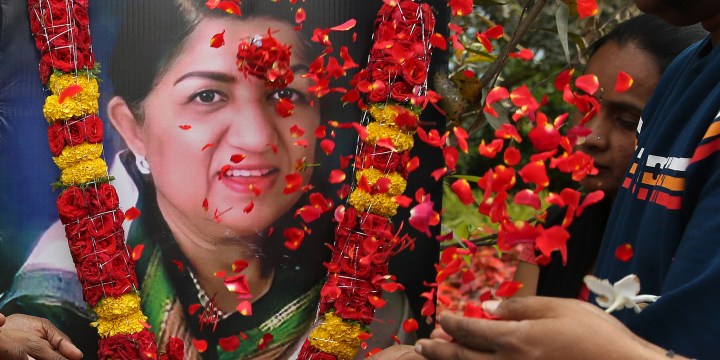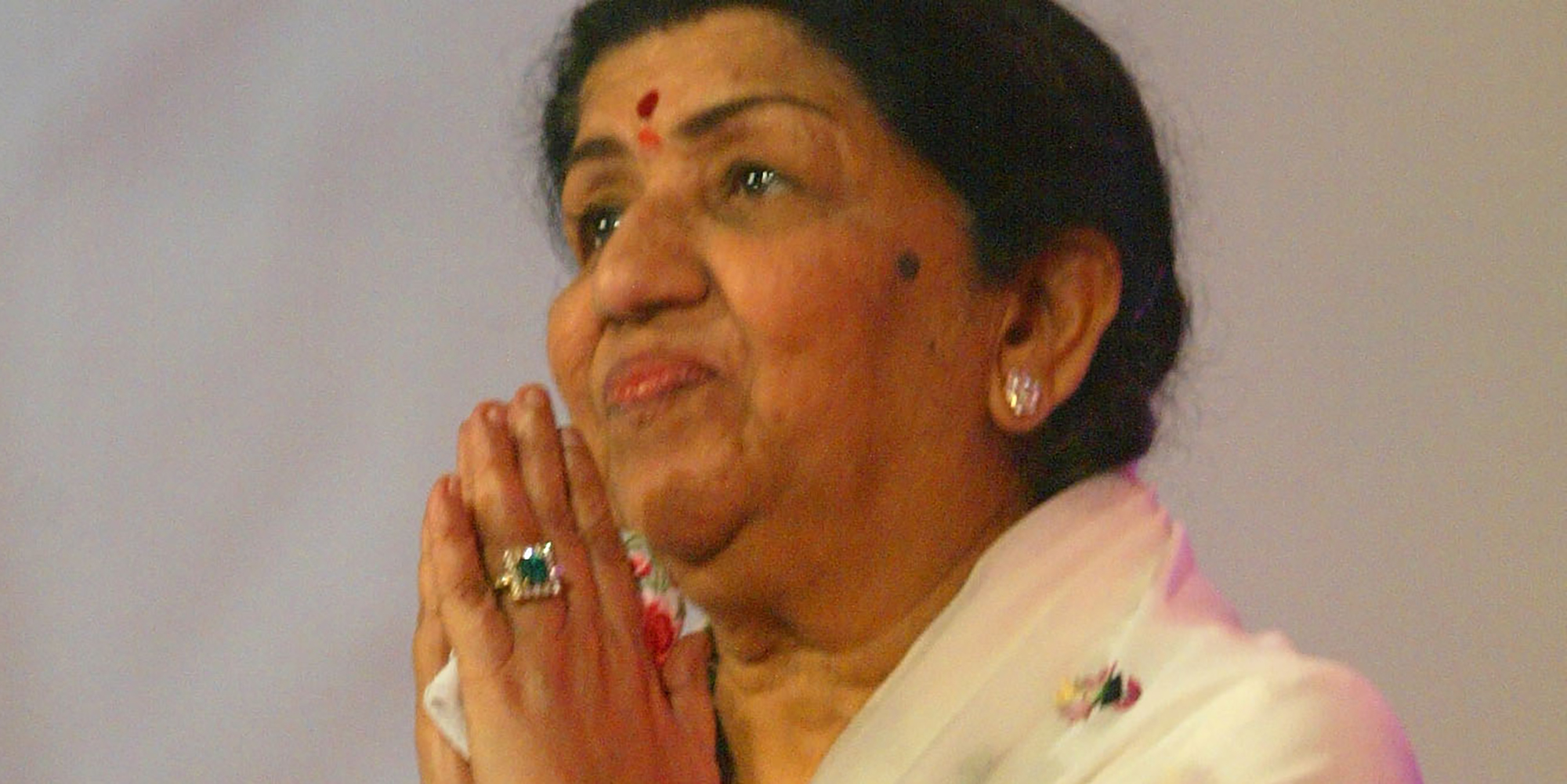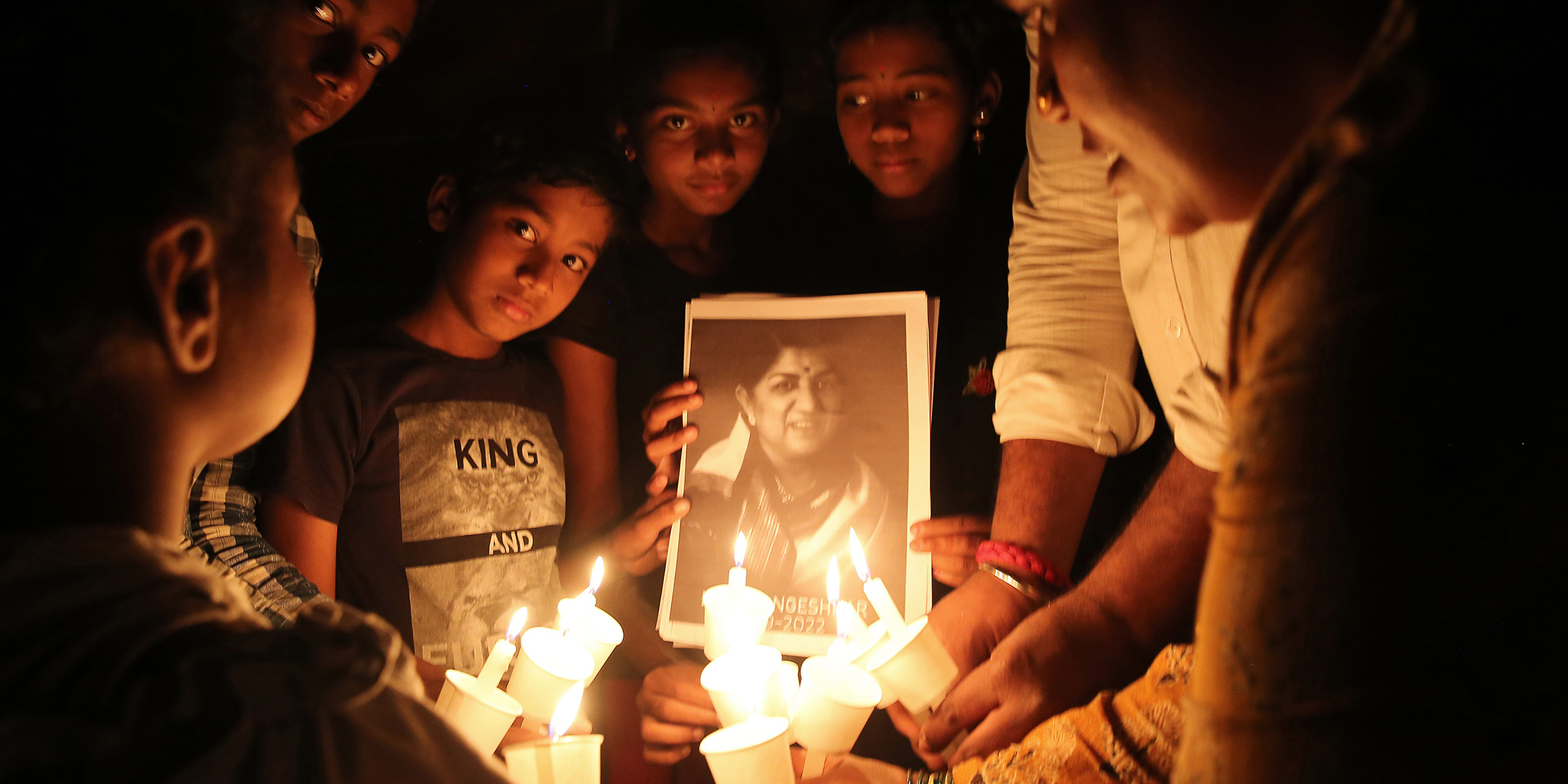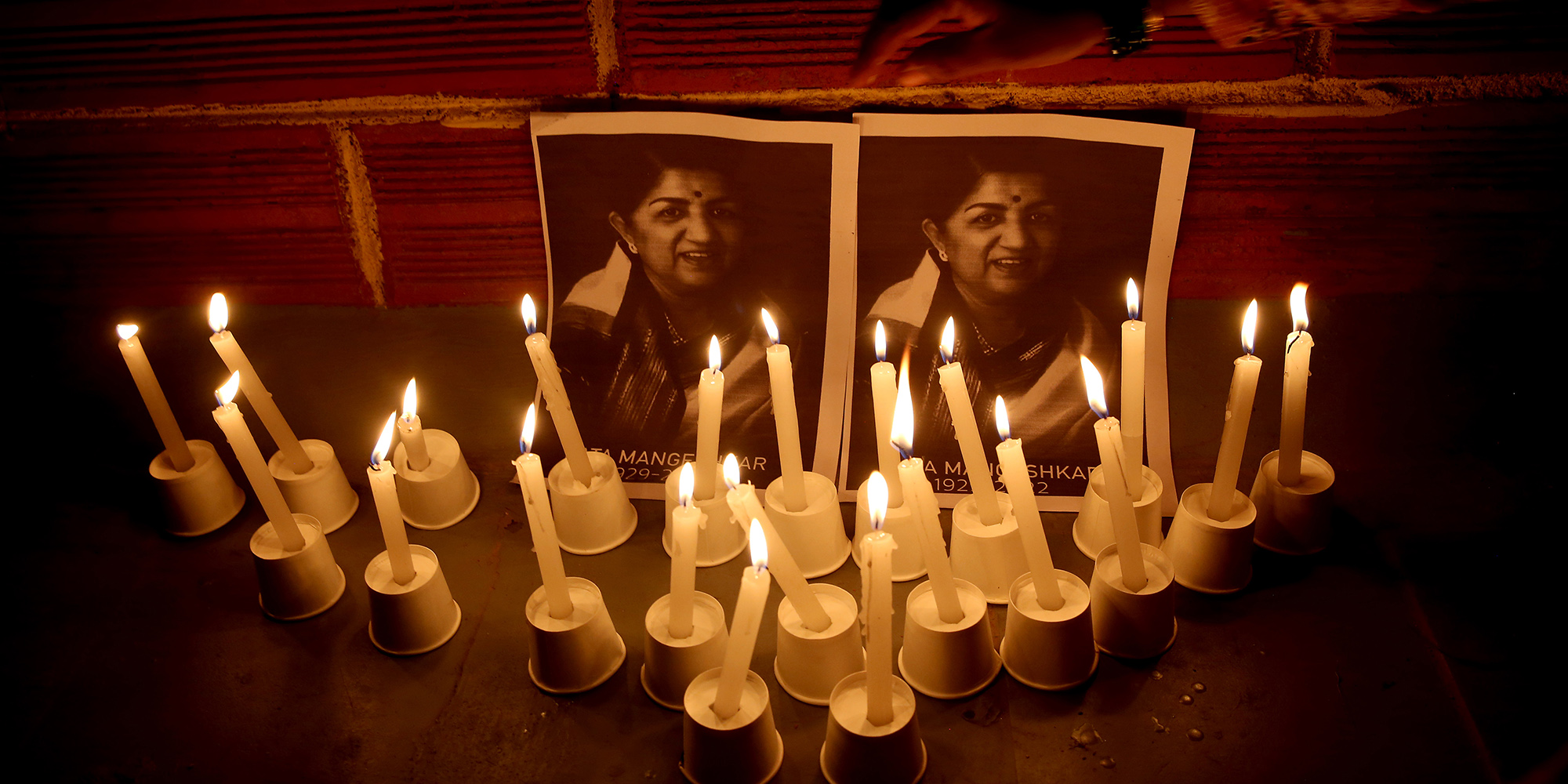IN MEMORIAM: LATA MANGESHKAR
The Nightingale of India and the song that changed it all

The great Lata Mangeshkar, known as the Nightingale of India, died on Sunday. Her songs were the soundtrack to the lives of millions of people of Indian descent, but one song propelled her to stardom.
This past weekend, I’d wager that hundreds of millions of Indians throughout the diaspora would have found themselves humming or singing softly to themselves. They would have been from different generations, and the songs they chose wouldn’t have been the same either – drawn as they would have been from a vast collection spanning different genres, languages and time periods. The one thing they’d have had in common would be that they were all sung by that great Nightingale of India, Lata Mangeshkar.
Lata Mangeshkar, or Didi as she was fondly known, died on Sunday in Mumbai at the age of 92. Hers was an experience that had no equivalent in the world, certainly not in the West.
To a foreigner, it is difficult to describe the ubiquitousness of her voice or what it has come to mean to so many. For people of North Indian extraction – generation after generation alive since India gained independence in 1947 – it is little exaggeration to say she has been the soundtrack to our lives. We sang with her, we danced to her, we were consoled by her, and always, we were moved by her.
Mangeshkar was a Bollywood playback singer who, beginning in the late 1940s, gifted to the world the most exquisite repertoire of filmi songs, ghazals, bhajans and classical recordings. She was the voice for scores of actresses revered as goddesses by the public – in large part because of the voice she bestowed on to them. Mangeshkar recorded an unknown number of songs – Guinness World Records once tried to keep count and went up to around 25,000. This of course isn’t the point – rather, her monumental impact has been how she was able to touch so many people in the most inspired of ways. While Hindi cinema is widely regarded as the flagbearer of the country’s national identity, what gives it its soul and shapes, its collective memory is its music. A thousand films a year are produced, mostly what one would charitably call of uneven quality and soon forgotten – what is remembered, that which is consecrated, are the songs that appear in those films, mouthed by the actors but sung by playback singers.

Lata Mangeshkar waits to receive her Inspiration award during the Inaugural MTV IMMIES at the Goregaon Sports Club, 12 December 2003 in Mumbai, India. (Photo: Daniel Berehulak / Getty Images)
Oh, the songs! The famous Bollywood actor Amitabh Bachchan has said of music that it is such a part of Indians’ psyche, we wouldn’t know what to do with ourselves if we couldn’t sing or listen to it, all the time. And where to begin with Mangeshkar’s songs? It is impossible to do justice to all of them – combining the contribution of Beethoven, Mozart and Bach may begin to approximate her contribution to Indian popular culture. And so, as a tribute, I’ve decided to focus on just one; the one that started it all.
***
It is 1949, and in Calcutta an English correspondent writes a review of the newly released Mahal, director Kamal Amrohi’s unconventional attempt at Gothic horror; a moody, tempestuous film of ghosts and prior love hauntingly shot in the German Expressionist manner by Josef Wirsching. The correspondent does not care too much for the film but is taken by the film’s femme fatale. “Madhubala looks like a vision and sings like an angel,” he writes of the 16-year-old actress, and in reference to the song Aayega Aanewala, which appears as the central motif in the film.
Khamosh hai zamaana chup chaap hain sitaare
Aaram se hai duniya bekal hai dil ke maare
Aise mein koi aahat, is tarah aa rahi hain
Jaise ki chal raha ho mann mein koi hamaare
Ya dil dharak raha hain is aas ke sahaare
(Time has no movement. The stars have fallen silent, the world at rest
But lovers are uneasy and my heart remains uneasy
And suddenly, I hear the approach of footsteps
As if someone is passing through my soul)
Who has sung this song like an angel? It’s a sign of the times and the lingering respect accorded to English cultural arbiters, that a year and a half after independence the correspondent is allowed to write reviews of Hindi movies without fully understanding the nuances of its cinema. Perhaps I’m being unkind – for traditionally, the actors coming from classical, theatrical and musical traditions (such as Durga Khote, Devika Rani and Nurjehan) would have all sung their own songs. Maybe the correspondent had been particularly moved by KL Saigal, the most famous singing star in Calcutta and Bombay. Saigal had only recently died, and this new development – actors chosen for their acting ability alone, with songs separately recorded in a studio by professional playback singers – is in its relative infancy.
Nor is the correspondent alone – even the HMV gramophone record company doesn’t seem to know much about the new playback singer, for the Famous Recording Studio hasn’t informed them. On the listing of the film’s soundtrack, the artist’s name is listed as “Kamini” – that of Madhubala’s ghostly character.
In reality, the artist with the ethereal voice, as the subcontinent will soon come to know, is 19-year-old Lata Mangeshkar.
Waiflike, with a slightly haunted look in her eyes and living precariously with five other members of her family in Nanachowk, Mangeshkar had been singing in films for a few months, most promisingly for the noted music director Ghulam Haider in Majboor (1948). She’s also appeared in front of the camera in several Marathi-language films. But Aayega Aanewala is to be the song that transforms her life.

Fans hold candles during candlelight vigil for legendary singer Lata Mangeshkar in Bangalore, India, 6 February 2022. (Photo: EPA-EFE / Jagadeesh NV)
Decades later, she’d recollect those days to the documentary filmmaker Nasreen Munni Kabir.
“I worked hard, recording songs from morning to night. Running from one studio to another… I ended up going hungry all day because I didn’t even know recording studios had canteens and I could buy something to eat or get some tea. I often went without food and water for the whole day. The only thought that preoccupied me was how to look after my family. Somehow.”
Mangeshkar’s straitened conditions stemmed from her father, Deenanath’s premature death, aged 42, a few years previously, and before that his own fall from financial grace. Mangeshkar may appear apprehensive and unsure of herself, yet her father bequeathed one thing to his young daughter – a solid musical education. Deenanath had been a stage actor and theatre promoter, classically trained in music himself. He was able to give the young Lata a musical grounding, and after his death his colleagues arranged for her to further her training.
Ghulam Haider, tapping on his cigarette tin box for rhythm while on a railway station platform, is able to detect Mangeshkar’s potential and uncanny ability to master the tone and emotional import of a song. He begins to record her and passes her name on to other music directors, such as Khemchand Prakash. Later that year, 1948, Prakash picks her for his next project, Mahal in which the spectral song will feature prominently.
***
Aayega, aayega, aayaga
Aayega aanewale, aayega
Deepak baghair kaise parwaane jhal rahe hain?
Koi nahin chalaata aur teer chal rahe hain
Tadpega koi kab tak, be-aas be-sahaara
Lekin yeh keh rahin hain, dil ke mere ishaare
Aayega aanewala
(He will come, he will come
He will come, he who is to come
How are the moths burning without a flame?
No shot fired, yet the arrow flies
How long will I remain tormented, without hope?
Yet a voice resides within me, saying
He will come, he will come)
It is a most unconventional structure for a song, a brave gambit. Firstly, its length – over seven minutes, with a long a capella opening, something uncommon in film music. Then come its distinct shifts in tone and movement. And finally, the director’s choice of instruments – the strong piano chords most prominently, but also the use of bassoon. (In the opening scenes of the movie, Prakash would also use a guitar, strings almost loose, to highlight the addled mind of the main character as he discerns the outline of the ghost haunting an old mansion.)
He and the film’s director, Kamal Amrohi, intend to go further still to heighten the atmosphere. Lacking the latest audio equipment, they simply instruct Mangeshkar to begin singing a few metres away from the microphone for the opening bars so that her voice begins indistinctly, gradually moving closer.
Mangeshkar’s singing is sublime and otherworldly. Though they spend a whole day rehearsing, lack of sophisticated musical equipment means the final recordings (there are several versions used in the film) each have to be done in a single take – but Mangeshkar is able to do it seamlessly. Though she is Marathi-speaking, her diction in Urdu (the medium of the lyrics) is excellent – her rendering of the word “duniya” is still to be refined, yet the more difficult “baghair” is complimented upon by observers.

Fans light candles in front of the photographs of legendary singer Lata Mangeshkar during a candlelight vigil in Bangalore, India, 6 February 2022. (Photo: EPA-EFE / Jagadeesh NV)
It will be several months before the film, and the song, are finally released – and “Kamini” is finally revealed to the world as Mangeshkar. Nothing is the same after that.
***
If only this were a Bollywood movie, and that last sentence were true. It wasn’t quite like that, of course, and there still remained much to struggle for in Mangeshkar’s life. While the song brought her success, it also to an extent sowed the seeds for her future determination – to always ensure she would receive sufficient credit and compensation for her work. Her experiences of not being named as the singer of Aayega Aanewala led to her fight first for billing, and then for equal compensation with male counterpart singers, which she would also achieve years later.
***
All that remains with us now are her songs and her immaculate voice. And each of our personal recollections of our own lives, with her creating the background soundtrack to each of them.
On Sunday, as her body was taken away from the Mumbai hospital where she died to the nearby Shivaji Park, thousands lined up nearby to pay their last respects. Among the many songs they chanted, one was often repeated:
Rahe na rahen hum, mehaka karenge
Banke kali, banke sabaa, bagh-e-wafa mein
(Whether or not I am here, this fragrance will remain
As if a flower, as if a breeze in our devoted garden) DM
Kalim Rajab is a director of the New National Assurance Company, SA’s largest empowered insurance company. He previously worked in the diamond industry, and was educated at UCT and Oxford. He writes in his personal capacity about South Africa, current events, film appreciation and culture. Catch him on Twitter at @kalimrajab
[hearken id=”daily-maverick/9072″]



















 Become an Insider
Become an Insider
Thank you for sharing that, Kalim. Her voice is magical. As someone newly woken to Indian music by the movie ‘The Disciple’, I’m glad to have a new figure and musical genre to listen to.
Brings back memories of going to the Avalon Cinema, all dolled up, to watch a “double feature” Bollywood movies on a Saturday night.
The music of Lata together with Mohammed Rafi and Mukesh (my namesake) were ubiquitous in all the Indian immigrant houses and cars.
Oh, the nostalgia…